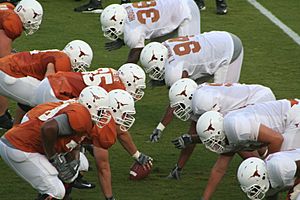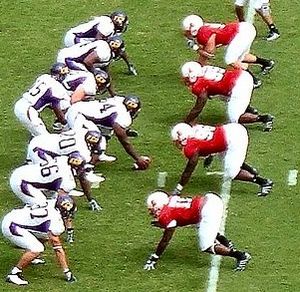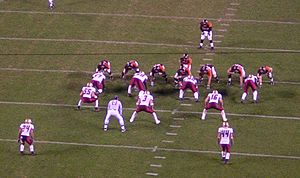American football positions facts for kids
In American football, each player on the field has a special job, called their "position." A team can have 11 players on the field at one time. Teams can also change players whenever the ball is not in play. This has led to three main groups of players: the offense, the defense, and special teams. Each group has different positions based on what the players need to do.
Contents
Offense
The offense is the team that has the football. Their goal is to move the ball down the field and score points. The 11 players on offense are split into two main groups. Five players are offensive linemen. Their main job is to block opponents and protect their quarterback. The other six players are backs and receivers. Their main job is to move the ball by running or passing.
The rules say that at least seven players must be on the line of scrimmage (the imaginary line where the play starts). No more than four players can be behind this line. Only the players behind the line and the two players at the ends of the line can touch the ball during a normal play. These players are called "skill positions" or "eligible receivers." The other players, called "interior linemen," cannot catch forward passes. Even with these rules, coaches create many different ways to line up players. These are called "formations."
The positions below are common in almost every game. Teams might arrange them differently based on their game plan.
Offensive (interior) line
The offensive line's main job is to block the other team's defensive line. They protect their quarterback. Offensive linemen usually do not touch the ball, except for the center who starts the play.
Center (C)
The center starts each play by snapping the ball to the quarterback. The center usually plays in the middle of the offensive line. Like all offensive linemen, the center blocks defensive players. The center also often tells other linemen who to block.
Offensive guard (OG)
Two guards line up right next to the center. Their job is to block for both running and passing plays. Sometimes, a guard will "pull" out of their spot. They run ahead to block for a player carrying the ball. This happens on plays like "traps" or "sweeps."
Offensive tackle (OT)
Two tackles play outside of the guards. Their main job is to block for running and passing plays. The left tackle often protects the quarterback's "blind side" (where the quarterback can't see a defender coming). This player is usually very skilled. Tackles are often taller and have quick feet.
Backs and receivers (R)
Four players line up behind the line of scrimmage. Also, two receivers line up at each end of the line. There are four main positions in this group:
Quarterback (QB)
The quarterback gets the ball from the center to start the play. This is a very important position. The quarterback gets the play from the coaches. They tell the other offensive players what to do in the huddle. The quarterback might even change the play at the last second. This is called an "audible."
When the quarterback gets the ball, they can do three things. They can run with the ball themselves, which is called "scrambling." They can hand the ball to another player to run. Or, they can throw a forward pass to a player down the field.
Running back (RB/HB/FB)
Running backs line up behind the offensive line. They get the ball handed to them by the quarterback to run. A team might use one, two, or three running backs. The "tailback" or "halfback" is often the main player who runs with the ball. They can also catch passes. The "fullback" is usually bigger and stronger. Their main job is to block, but they can also run or catch passes.
Wide receiver (WR)
Wide receivers are experts at catching passes. They are usually fast and tall. Their main job is to run routes and get open for passes. They also sometimes block. Wide receivers usually line up "wide" near the sidelines. A receiver who is right on the line of scrimmage is called a "split end." A receiver who lines up behind the line is called a "flanker."
Tight end (TE)
Tight ends play next to the offensive tackles. They are "hybrid players" because they are a mix of a wide receiver and an offensive lineman. They often block, especially on running plays. But because they can catch passes, they are also targets for the quarterback.
Teams use different numbers of running backs, wide receivers, and tight ends. This depends on their coaches' plans and the players' skills. For many years, a common setup was one quarterback, two running backs, two wide receivers, and one tight end. Today, teams use many different formations. Some use three running backs and two tight ends. Others use four or five wide receivers and no running backs.
Defense
The defensive team, or "defense," starts a play without the ball. Their goal is to stop the other team from scoring. They also try to get the ball back for their own team. The defense does this by stopping the offense from getting a first down. This forces the offense to punt. They can also get the ball back by recovering an offensive fumble or intercepting a pass.
Unlike the offense, the rules do not limit where defensive players can line up. A defensive player can be anywhere on their side of the line of scrimmage. Over time, defensive roles have become clear. There are three main groups of defensive players.
Defensive line (DL)
Like the offensive linemen, defensive linemen line up right on the line of scrimmage. There are two main positions on the defensive line:
Defensive tackle (DT)
Defensive tackles play in the middle of the defensive line. Their job is to rush the passer and stop running plays up the middle. The tackle who lines up right across from the offense's center is often called a "nose tackle." Most defenses have one or two defensive tackles.
Defensive end (DE)
Defensive ends line up outside of the defensive tackles. They are the "ends" of the defensive line. Their job is to attack the passer or stop runs that go to the outside edges of the line. This is often called "containment." The faster defensive end is usually on the right side of the defensive line. This is because it's the right-handed quarterback's blind side.
Defensive linemen often put one or both hands on the ground before the ball is snapped. This is called a "three-point stance" or "four-point stance." This helps tell them apart from linebackers, who stand up.
Linebackers (LB)
Linebackers play behind the defensive line. They have many jobs. They can rush the passer, cover receivers, and stop running plays.
Middle linebacker (MLB)
The middle linebacker is often called the "quarterback of the defense." They often tell the other defensive players what to do. They must be able to stop running backs, cover passes over the middle, and rush the quarterback on blitz plays.
Outside linebacker (OLB)
Outside linebackers have different names based on their role. Some play on the "strongside" (SLB) or "weakside" (WLB). The strongside linebacker lines up on the same side as the offensive tight end. They often cover the tight end or a running back. The weakside linebacker lines up on the side without a tight end. They often rush the quarterback or cover a running back.
Defensive backs (DB)
Defensive backs, also called the "secondary," play behind the linebackers or near the sidelines. Their main job is to defend against pass plays. They are also the last line of defense on running plays. They need to be good at tackling players in the open field. A normal defense has two cornerbacks and two safeties.
Cornerback (CB)
Cornerbacks try to stop passes. They do this by batting the ball away from the receiver. Or, they can catch the pass themselves. When the offense runs, cornerbacks try to keep the runner inside the field. They want the runner to be tackled by other defenders.
Safety (S)
The safeties are the furthest players from the line of scrimmage. They are the last line of defense. They usually help the cornerbacks cover long passes. The strong safety (SS) is usually bigger and stronger. They help stop run plays and often line up closer to the line. The free safety (FS) is usually smaller and faster. They are often the deepest player on defense. They help cover long pass plays.
Nickelback and dimeback
Sometimes, a defense will use extra defensive backs to cover more receivers. A formation with five defensive backs is called a "nickel" formation. The extra defensive back is called a "nickelback." A formation with six defensive backs is called a "dime package." The sixth defensive back is called a "dimeback."
Defensive formations often use numbers. The first number is for defensive linemen. The second number is for linebackers. For example, a 3–4 defense has three defensive linemen and four linebackers. A 4–3 defense has four defensive linemen and three linebackers.
Special teams

Special teams are the groups of players on the field during kicking plays. Many players on offense or defense also play on special teams. But some players have special jobs just for kicking plays.
Kicking specialists
Kicking specialists are in charge of kicking the football. Their jobs change depending on the type of kick.
Kicker (K)
Also called a "placekicker," kickers handle kickoffs, extra points, and field goals. For these kicks, the kicker kicks the ball off the ground. It can be held by another player or placed on a tee. Some teams have two kickers: one for extra points and field goals, and another for kickoffs. Most teams use one kicker for both.
Punter (P)
The punter usually lines up far behind the line of scrimmage. After getting the ball, the punter drops it and kicks it from the air. They do this to give the ball to the other team and send it as far downfield as possible. This is usually done on fourth down.
Other special teams positions
Most other special teams players are also backups for other positions.
Holder (H)
The holder is usually about 7–8 yards from the line of scrimmage. They hold the ball for the placekicker to kick. This player is often a backup quarterback or a punter. They are good at catching the ball and handling snaps.
Long snapper (LS)
The long snapper is a special center. They snap the ball a long way back to the holder or punter. They are usually bigger players, like tight ends or linebackers. They need to be big enough to block. They also need to be athletic enough to run down the field and tackle the returner.
Kick returner (KR) and punt returner (PR)
Returners catch kicked balls (kickoffs or punts). Then, they run the ball back as far as they can. These players are usually among the fastest on the team. They often play wide receiver or cornerback. Teams might use the same player for both jobs. Or, they might have one player for punts and another for kickoffs.
Upback
The upback is a blocking player who lines up a few yards behind the line of scrimmage during punts. They often tell the long snapper when the punter is ready. Their main job is to block for the punter. Sometimes, on a trick play, they might get the snap and run or pass the ball. Upbacks are usually backup running backs or linebackers.
Gunner
A gunner is a player on kickoffs and punts. They run down the field very fast to try and tackle the returner. They usually line up near the sidelines. This gives them fewer blockers to get around. Wide receivers and cornerbacks often play as gunners.
Jammer
Jammers try to slow down the gunners during punts or kickoffs. This gives the returners more time to run the ball.






